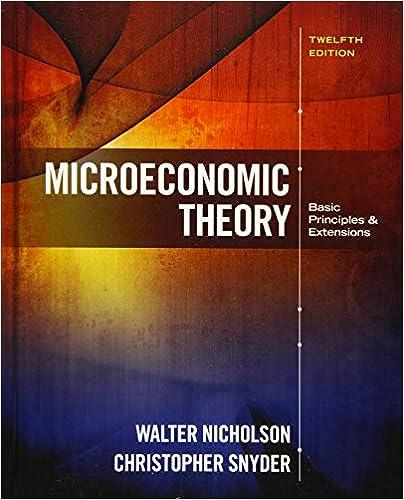Proof of the envelope theorem in constrained optimization problems Because we use the envelope theorem in constrained
Question:
Proof of the envelope theorem in constrained optimization problems Because we use the envelope theorem in constrained optimization problems often in the text, proving this theorem in a simple case may help develop some intuition. Thus, suppose we wish to maximize a function of two variables and that the value of this function also depends on a parameter, a: f 1x1, x2, a2. This maximization problem is subject to a constraint that can be written as: g 1x1, x2, a2 5 0.
a. Write out the Lagrangian expression and the first-order conditions for this problem.
b. Sum the two first-order conditions involving the x’s.
c. Now differentiate the above sum with respect to a—this shows how the x’s must change as a changes while requiring that the first-order conditions continue to hold.
d. As we showed in the chapter, both the objective function and the constraint in this problem can be stated as functions of a: f 1x1 1a2, x2 1a2, a2, g 1x1 1a2, x2 1a2, a2 5 0. Differentiate the first of these with respect to
a. This shows how the value of the objective changes as a changes while keeping the x’s at their optimal values. You should have terms that involve the x’s and a single term in ∂f/∂a.
e. Now differentiate the constraint as formulated in part (d)
with respect to
a. You should have terms in the x’s and a single term in ∂g/∂a.
f. Multiply the results from part
(e) by λ (the Lagrange multiplier), and use this together with the first-order conditions from part
(c) to substitute into the derivative from part (d). You should be able to show that df 1x1 1a2, x2 1a2, a2 da 5 ∂f
∂a 1 λ
∂g
∂a
, which is just the partial derivative of the Lagrangian expression when all the x’s are at their optimal values. This proves the envelope theorem. Explain intuitively how the various parts of this proof impose the condition that the x’s are constantly being adjusted to be at their optimal values.
g. Return to Example 2.8 and explain how the envelope theorem can be applied to changes in the fence perimeter P—that is, how do changes in P affect the size of the area that can be fenced? Show that, in this case, the envelope theorem illustrates how the Lagrange multiplier puts a value on the constraint.
Step by Step Answer:

Microeconomic Theory Basic Principles And Extensions
ISBN: 9781305505797
12th Edition
Authors: Walter Nicholson, Christopher M. Snyder






